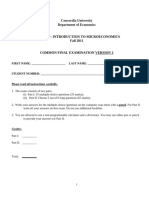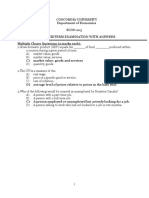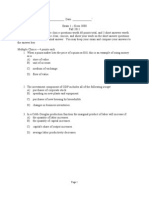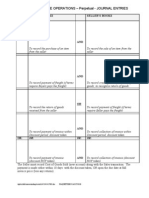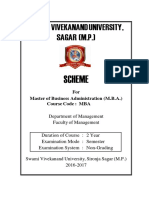Econ 212 Final Exam Practice
Econ 212 Final Exam Practice
Uploaded by
codsocCopyright:
Available Formats
Econ 212 Final Exam Practice
Econ 212 Final Exam Practice
Uploaded by
codsocOriginal Description:
Original Title
Copyright
Available Formats
Share this document
Did you find this document useful?
Is this content inappropriate?
Copyright:
Available Formats
Econ 212 Final Exam Practice
Econ 212 Final Exam Practice
Uploaded by
codsocCopyright:
Available Formats
Econ 212 Final Exam Fall 2011 Instructor: C. J.
Bondi 85 points for a 75 point base
1. Circular Flow Diagram (4 points). The circular flow diagram represents market interactions in the product market and the resource market between businesses and households in the private closed economy model. (a) (b) (c) (d) By closed economy, we mean ___________ By private economy, we mean ______________ Crude oil is traded in which market? _________ 87 octane gasoline used in an automobile is traded in which market? ___________
2. Conditions for Trade (10) points total) Production Possibilities Frontier, Opportunity Costs, Absolute Advantage, Comparative Advantage, Terms of Trade. (10 points) Pat and Kris spend 15 hours each day producing either brewing root beer or baking pizza. Pat takes 5 hours to brew a gallon of root beer and 3 hours to bake a pizza. Kris takes 3 hours to brew a gallon of root beer and 5 hours to bake a pizza.
pizzas
gallons of root beer
a. Draw the PPFs for Pat and Kris on the axes above. Assume the relevant time period is a 15 hour day. Show the intercepts and slopes for Pat and Kris. (2 points) b. The producer with the absolute advantage in pizza is _______________ For credit, explain your answer. (2 pts).
c. The producer with the comparative advantage in root beer is ____________ . For credit, explain your answer using the idea of opportunity cost. (2 pts.)
d. If Pat and Kris trade with each other, who will trade away (sell) pizza in exchange for (in order to purchase) root beer? For credit, explain your answer using the idea of comparative advantage. ( 2 points)
e. In this trading situation, price of pizza can be expressed in terms of gallons of root beer, and vice versa. What is the maximum price that the purchaser of pizza will pay in terms of root beer? (hint: use the idea of opportunity cost as expressed on the PPF.) (2 pts).
3. Various Chapter 4 Kinds of Questions (13 points) 3.1. Good A is a complement to good B. If the price of good B falls, we expect demand for good A to ______________. (choose from: fall, rise, or stay the same) 3.2. If quantity demanded for good A increases when income falls, good A is a (n) _______ good. 3.3. If quantity demanded for good A increases when income increases, good A is a(n) _________ good. 3.4. Equilibrium is at $6. At $4, we expect a condition of _________ (hint, compare quantity demanded and quantity supplied at $4. 3.5. Equilibrium is at $6. At a price of $8, we expect a condition of ___________. (same similar to the previous) 3.6-7. Equilibrium is at $6. Supply increases. The new equilibrium price will be (a) greater (b) lower (choose one) than $6. Show on the diagram. 3.6-7: P 3.8-9: P
3.8-9. Equilibrium is at $6. Demand increases. The new equilibrium price price will be (a) greater (b) lower (choose one) than $6. Show on the diagram above.
10-13. If QD = 90 3P and QS = 9 + 6P, show the demand curve, the supply curve, and the equilibrium price and quantity below, and accurately compute the intercepts and equilibrium price and quantity.
Q
28-31. Elasticity Computations. Show all work. Suppose the demand schedule for compact discs is as follows: Price Quantity Demanded (Income = $8,000) Quantity Demanded (Income = $10,000) $8 32 45 10 24 30 12 16 20 14 8 12 16 4 6
28-29. Use the midpoint formula to calculate the price elasticity of demand as the price increases from $8 to $10 if income = $8,000. Then, do the same if income = $10,000.
30-31. Use the midpoint formula to calculate the income elasticity of demand as the income increases from $8,000 to $10,000 if price = $10. Then, do the same if price = $16.
32-38 Elasticity Implications for Revenue (hint: do not use the midpoint formula in this section) 32 . Write the definition of price elasticity of demand in percentage change (% ) form (not the midpoint computation formula), _____________________ 33 Suppose the price elasticity of demand = -- 1.5. Then, if an items price falls by 1%, the items quantity demanded will rise by __________% 34 Expanding upon the idea from the previous question, if price elasticity of demand = -- 1.5 and a $100 item whose demand quantity is 200 falls in price to $98, then the predicted change in quantity is _____________%. (show the work)
35 Based on the answer to the previous question, the predicted demand quantity is now ____________ (show the work). 36. Compare the revenue for this item before _____________ and after ____________ the price change. (show the work) 37. Generalize what you have just demonstrated: when price elasticity of demand has absolute value greater than one, and price falls, we expect revenue to (choose one) (a) increase (b) decrease because 38. the % change in quantity is ________________ than the % change in price, in absolute value.
39-51 Equilibrium, Welfare and Trade (13 points)
a. Q = 16 P; Q = P for a good in the country of Econia, a closed economy. Derive and show the equilibrium price and quantity; Compute the consumer surplus (CS) and the producer surplus (PS). Show all calculations. Show the curves, including the intercepts, the equilibrium price and quantity, and the CS and PS on the diagram below. (8 points).
D S
b. (5 points) Suppose the previous situation is opened to international trade. If the world price is $6: b.1 Will Econia be an importer or an exporter of the good in discussion? Why? b.2 Compute and identify the import (or export) amount on the above diagram. It will be helpful to use a horizontal line to indicate the world price. b.3 Between consumers and producers in Econia, which benefits from opening Econia to trade? Use the ideas of consumer surplus and producer surplus in your answer; i.e., whose surplus increases and whose decreases. You do not need to recompute the consumer and producer surpluses.
Price (P)
Quantity (Q)
Taxes & Externalities ( 5 points)
52 The uncompensated impact of one persons actions on the well-being of a bystander is a(n)___________________. 53 If the production of a good has a negative externality, and no policy intervention is taken, the following is not a likely result: (a) private costs understate social costs (b) deadweight loss due to underconsumption and under production (c) inefficient resource allocation due to a failure to account for the full costs of production (d) deadweight loss due to overproduction (e) producers private costs will understate social costs. 54 A tax that is designed to internalize the externality by inducing private decision makers to take account of the social costs that arise from a negative externality of their actions is a ______________ tax. 55. The (average or marginal, choose one) tax rate is relevant when considering the full tax burden an individual will pay. 56. The (average or marginal, choose one) tax rate is relevant when considering how to motivate changes in behavior.
Chapter 12 - Design of the Tax System 57 - 60. Use Table A to complete Table B.
TABLE A On Taxable Income Up to $30,000 From $30,001 to $100,000 From $100,001 to $200,000 From $200,001 to $300,000 Over $300,000 The Tax Rate Is 0% 5% 10% 20% 30%
TABLE B Taxpayer John Todd Glen Jake Income $50,000 $130,000 $240,000 $310,000 Tax Amount Average Tax Rate
61. Suppose a country imposes a lump-sum income tax of $5,000 on each individual in the country, and no other income tax. What is the marginal income tax rate for an individual who earns $40,000 during the year? (a) 0% (b) 10% (c) More than 10% (d) The marginal tax rate cannot be determined without knowing the entire tax schedule. 62. Suppose a country imposes a lump-sum income tax of $5,000 on each individual in the country and no other income tax. What is the average income tax rate for an individual who earns $40,000 during the year? (a) 0% (b) 10% (c) More than 10% (d) The average tax rate cannot be determined without knowing the entire tax schedule. 63 Country As tax system is more efficient than Country Bs tax system if (a) Country A collects less tax revenue than Country B, and the cost to taxpayers is the same in both countries. (b) Country A collects more tax revenue than Country B, even though the cost to taxpayers is greater in Country A than in Country B (c) the same amount of revenue is raised in both countries, but the taxes are collected in a shorter amount of time in Country A than in Country B. (d) the same amount of revenue is raised in both countries, but the cost to taxpayers is smaller in Country A than in Country B.
Chapter 18 The Markets for Factors of Production 64. The production function is the (a) increase in the amount of output from an additional unit of labor. (b) marginal product of an input times the price of output. (c) relationship between the quantity of inputs and output. (d) shift in labor demand caused by a change in the price of output.
Table 18-1 Number of Workers (L) 1 2 3 4 Output of Firm A 100 200 300 400 Output of Firm B 100 300 600 1,000 Output of Firm C 100 190 270 340 Output of Firm D 100 80 60 40
65. Refer to Table 18-1. Which firms production function exhibits diminishing and positive marginal
product? (a) Firm D (b) Firm B (c) Firm C (d) Firm A Scenario 18-1 (not related to Table 18-1) Harry owns a snow-removal business. He hires workers to shovel driveways for him during the winter. The first worker he hires can shovel twelve driveways in one day. When Harry hires two workers, they can shovel a total of 22 driveways in one day. When Harry hires a third worker, he shovels an additional eight driveways in one day. 66. Refer to Scenario 18-1. What is the marginal productivity of the second worker? (a) 7 (b) 10(c) 12 (d) 22. 67. Refer to Scenario 18-1. What is the total productivity of three workers? (a) 12 (b) 30 (c) 22 (d) 42 68. Refer to Scenario 18-1. Suppose that Harry pays each worker $80 per day and that he charges each customer $15 to have his driveway shoveled. What is the value of the marginal product of labor for the second worker? (a) $200 (b) $240 (c) $150 (d) $960 69. Refer to Scenario 18-1. Suppose that Harry pays each worker $80 per day and that he charges each customer $15 to have his driveway shoveled. What is the value of the marginal product of labor for the third worker? (a) $160 (b) $640 (c) $1,600 (d) $120 (70 74) Suppose that labor is the only input used by a perfectly competitive firm. The firms production function is as follows (next page): 70. Calculate the marginal product for each additional worker. 71. Each unit of output sells for $10. Calculate the value of the marginal product of each worker. 72. Compute the demand schedule showing the number of workers hired for all wage levels from zero to $100 per day. 73. Graph the firms demand curve for labor on the axes below.
Demand Schedule Days of Labor Units of Output Marginal Product Value of Marginal of Labor Product of Labor wage levels nr workers
0 1 2 3 4 5 6 7
0 6 12 18 24 27 28 28
wages
Nr of workers.
74. What happens to this demand curve if the price of output rises from $10 to $12?
Chapter 19 Wages and Discrimination
75.. Effective minimum-wage laws will most likely (a) increase demand for labor.(b) create a surplus of labor, at least in some markets. (c) increase incomes for all unskilled workers. (d) decrease incomes for all unskilled workers. 76. Above-equilibrium wages caused by efficiency wages will most likely result in (a) a shortage of labor. (b) increased unemployment. (c) compensating wage differentials. (d) an decrease in the quantity of labor supplied.
77. If we were to observe above-equilibrium wages in a particular labor market, then a possible explanation might be that (a) the theory of efficiency wages holds true for that market. (b) there is a powerful labor union representing workers in that market. (c) workers are largely unskilled and/or inexperienced and minimum-wage laws are effectively holding wages up in that market. (d) All of the above are correct.
78. Which of the following statements is not correct? (a) Some firms pay wages that are above the equilibrium wage. (b) Workers sometimes form labor unions to push their wages up. (c) Wages never deviate from the balance of supply and demand in the market for labor. (d) The federal government mandates that employers pay their workers at least as much as the federal minimum wage. 79. Which of the following is not a consequence of above-equilibrium wages in a labor market? (a) a surplus of labor (b) unemployment (c) more unionized jobs (d) All of the above are consequences of above-equilibrium wages. 80. Which of the following is the most likely outcome of minimum wage laws? (a) an increase in both the quantity of labor supplied by workers and the quantity of labor demanded by firms (b) an increase in the quantity of labor supplied by workers and a decrease in the quantity of labor demanded by firms (c) a decrease in the quantity of labor supplied by workers and an increase in the quantity of labor demanded by firms (d) a decrease in both the quantity of labor supplied by workers and the quantity of labor demanded by firms
Figure 19-1
81. Refer to Figure 19-1. Some policymakers have argued that the government should establish a "living wage." A living wage would provide workers a reasonable standard of living in their city or region. If a living wage of $10 per hour is established in the market pictured here, we would expect (a) employment will increase to 14 million. (b) employment will decrease to 8 million (c) .there will be a surplus of 14 million workers. (d) the wage will actually rise to $20 per hour.
82. Refer to Figure 19-1. Suppose the local labor market was in equilibrium to begin with but then the largest local employer decided to change its compensation scheme to $10 as shown. Which of the following compensation schemes could the graph be illustrating? (a) Discrimination. (b) An efficiency wage. (c) A compensating differential. (d) The superstar phenomenon. 83. Refer to Figure 19-1. What is the loss associated with wages moving from $8 to $10? (a) 2 million jobs. (b) 8 million jobs. (c) 6 million jobs (d) 14 million jobs.
Figure 19-2 84. Refer to Figure 19-2. This figure depicts labor demand and supply in a nonunionized labor market. The original equilibrium is at point A. If a labor union subsequently establishes a union shop and negotiates an hourly wage of $20, then there will be an excess (a) supply of 3,000 workers. (b) supply of 4,000 workers. (c) demand of 7,000 workers. (d) supply of 7,000 workers. 85. Refer to Figure 19-2. This figure depicts labor demand and supply in a nonunionized labor market. The original equilibrium is at point A. If a labor union subsequently establishes a union shop and negotiates an hourly wage of $20, then the employment level (a) decreases from 10,000 to 3,000. (b) increases from 3,000 to 10,000. (c) increases from 6,000 to 10,000. (d) decreases from 6,000 to 3,000.
My signature on this document affirms that I have neither obtained nor given any assistance to another student on this exam and that I have not engaged in cheating, plagiarism, or any form of academic dishonesty in connection with this exam.
Name ________________________ Signature ______________________ Date _______________________
You might also like
- CFI Jeff Schmidt - Three Financial StatementsNo ratings yetCFI Jeff Schmidt - Three Financial Statements7 pages
- ECON 201 12/9/2003 Prof. Gordon: Final ExamNo ratings yetECON 201 12/9/2003 Prof. Gordon: Final Exam23 pages
- ECON 1550 Introduction To EconomicsEND-OF-SEMESTER EXAMINATION SEMESTER II, 2005/2006 SESSION100% (1)ECON 1550 Introduction To EconomicsEND-OF-SEMESTER EXAMINATION SEMESTER II, 2005/2006 SESSION17 pages
- Mock Midterm Exam Spring 2021 (1) - 111930No ratings yetMock Midterm Exam Spring 2021 (1) - 1119308 pages
- Answer: C: Refer To The Information Provided in Figure 7.2 Below To Answer The Following QuestionsNo ratings yetAnswer: C: Refer To The Information Provided in Figure 7.2 Below To Answer The Following Questions5 pages
- April 2, 2007 Name Circle: Center Left Right0% (2)April 2, 2007 Name Circle: Center Left Right8 pages
- Econ5103 Business Economics: Session 1 2014 Midsession Examination Sample PaperNo ratings yetEcon5103 Business Economics: Session 1 2014 Midsession Examination Sample Paper12 pages
- ECON 1550 Introduction To Economics END-OF-SEMESTER EXAMINATION SEMESTER III, 2004/2005 SESSIONNo ratings yetECON 1550 Introduction To Economics END-OF-SEMESTER EXAMINATION SEMESTER III, 2004/2005 SESSION16 pages
- CH 5: Merchandise Operations - Perpetual - Journal Entries: Buyer'S Books Seller'S BooksNo ratings yetCH 5: Merchandise Operations - Perpetual - Journal Entries: Buyer'S Books Seller'S Books6 pages
- Dnyansagar Institute of Management and ResearchNo ratings yetDnyansagar Institute of Management and Research17 pages
- Understanding Consumer Behavior Exploring Its Nature Scope and Application 20240408094400hnxuNo ratings yetUnderstanding Consumer Behavior Exploring Its Nature Scope and Application 20240408094400hnxu9 pages
- BAUD DURAND-Making Profits by Leading Retailers in The Digital Transition Carrefour Walmart AmazonNo ratings yetBAUD DURAND-Making Profits by Leading Retailers in The Digital Transition Carrefour Walmart Amazon38 pages
- Programmazione e Controllo Esercizi Capitolo 12No ratings yetProgrammazione e Controllo Esercizi Capitolo 1227 pages
- Investor Pitch Deck: Matchless Jewellery For Less LLPNo ratings yetInvestor Pitch Deck: Matchless Jewellery For Less LLP18 pages
- Principles of Microeconomics, Asia-Pacific Edition N. Gregory Mankiw all chapter instant download100% (1)Principles of Microeconomics, Asia-Pacific Edition N. Gregory Mankiw all chapter instant download47 pages
- CHAPTER 3 - Market Segmentation, Targeting and Positioning - Mac2023No ratings yetCHAPTER 3 - Market Segmentation, Targeting and Positioning - Mac202316 pages
- Macroeconomics: QuickStudy Laminated Reference GuideFrom EverandMacroeconomics: QuickStudy Laminated Reference Guide
- ECON 1550 Introduction To EconomicsEND-OF-SEMESTER EXAMINATION SEMESTER II, 2005/2006 SESSIONECON 1550 Introduction To EconomicsEND-OF-SEMESTER EXAMINATION SEMESTER II, 2005/2006 SESSION
- Answer: C: Refer To The Information Provided in Figure 7.2 Below To Answer The Following QuestionsAnswer: C: Refer To The Information Provided in Figure 7.2 Below To Answer The Following Questions
- Econ5103 Business Economics: Session 1 2014 Midsession Examination Sample PaperEcon5103 Business Economics: Session 1 2014 Midsession Examination Sample Paper
- ECON 1550 Introduction To Economics END-OF-SEMESTER EXAMINATION SEMESTER III, 2004/2005 SESSIONECON 1550 Introduction To Economics END-OF-SEMESTER EXAMINATION SEMESTER III, 2004/2005 SESSION
- Practice Problems in Statistics and Data ReductionFrom EverandPractice Problems in Statistics and Data Reduction
- Problems and Possibilities of the Us EconomyFrom EverandProblems and Possibilities of the Us Economy
- CH 5: Merchandise Operations - Perpetual - Journal Entries: Buyer'S Books Seller'S BooksCH 5: Merchandise Operations - Perpetual - Journal Entries: Buyer'S Books Seller'S Books
- Understanding Consumer Behavior Exploring Its Nature Scope and Application 20240408094400hnxuUnderstanding Consumer Behavior Exploring Its Nature Scope and Application 20240408094400hnxu
- BAUD DURAND-Making Profits by Leading Retailers in The Digital Transition Carrefour Walmart AmazonBAUD DURAND-Making Profits by Leading Retailers in The Digital Transition Carrefour Walmart Amazon
- Investor Pitch Deck: Matchless Jewellery For Less LLPInvestor Pitch Deck: Matchless Jewellery For Less LLP
- Principles of Microeconomics, Asia-Pacific Edition N. Gregory Mankiw all chapter instant downloadPrinciples of Microeconomics, Asia-Pacific Edition N. Gregory Mankiw all chapter instant download
- CHAPTER 3 - Market Segmentation, Targeting and Positioning - Mac2023CHAPTER 3 - Market Segmentation, Targeting and Positioning - Mac2023
